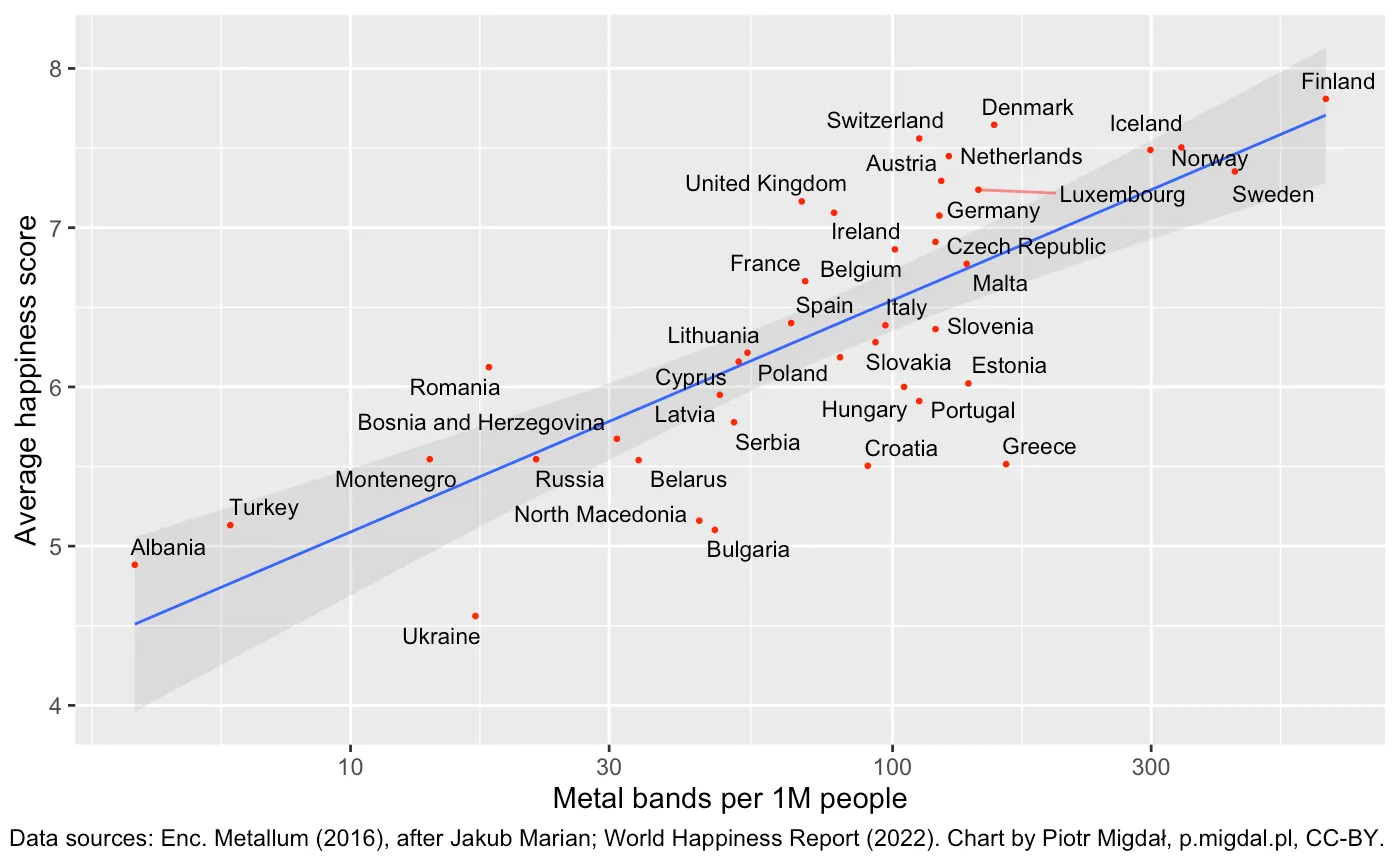Metal bands bring happiness (as chocolate brings Nobel Prizes)
21 Jan 2023 | by Piotr Migdał

Do metal bands bring happiness or maybe does happiness bring metal bands? For clarification, its about music groups - not personal ornaments!
Sources
Data comes from two sources:
- Encyclopaedia Metallum for metal bands count, 2016 (after Jakub Marian)
- World Happiness Report for the average happiness score, 2022
I got inspired by a map by Jakub Marian:
](/_astro/metal-bands-map-europe-jakubmarian.pbxIS55V_Zn3xKF.webp)
and this meme:
, compared to Polish music & society](/_astro/scandinavian-music-society-meme.5lwDVARz_10YQvM.webp)
If you want to explore the density of metal bands, see an Interactive Map of Heavy Metal Bands By Country Per 100,000 People.
“Chocolate brings Nobel Prizes” is a reference to There’s A Shocking Connection Between Eating More Chocolate And Winning The Nobel Prize. Ironically, this research article takes this correlation non-ironically. While not entirely implausible (chocolate contains a lot of healthy ingredients that improve cognitive functions), most likely this relationship diminishes a lot after controlling for GDP per capita. Sure, the Swiss have lovely chocolate and they eat a lot of it. But also live in one of the richest countries.
](/_astro/chocolate-consumption-nobel-laureates.DtZZZF3k_qk1zY.webp)
Disclaimer
Correlation is not causation. I don’t think there is a direct, causal link between metal bands and happiness. The title is intended to be humorous, not treated as real science! To the point that I didn’t care that much that I combine data from 2016 (metal band count) and 2022 (happiness score).
I picked European countries on purpose - as it is a region (but not the only one!) in which metal music is a thing. Plus, to get all countries with a label, I had to reduce the dataset somehow.
In other countries most likely it correlated to other locally popular music or other creative activities. While possible, I would be rather surprised if the correlation goes only for metal music.
I guess that it is about conditions that are favorable for creative activities. That is - disposable income and safety net, tolerance and freedom of speech.
Also, all surveys measuring happiness have their shortcomings. The answer might depend on the meanings of words in a given language or culture. Especially as Finland, a country with the highest density of metal bands is the happiest country in the world but also has relatively high suicide rates. If anything, results may make more sense within a given country:
](/_astro/money-can-buy-happiness-the-economist-2013.D_aA-gOa_17spE5.webp)
Source code
Generated in ggplot2. Since quite a few people asked about the code, I share it here to
library(ggplot2)
library(ggrepel)
df <- read.csv("./metal_bands_happiness.csv")
ggplot(df, aes(x=Metal.bands.per.capita, y=Score, label=Country.or.region)) +
scale_x_log10() +
stat_smooth(method = "lm", size = 0.5, alpha = 0.2) +
geom_point(color = "red", size = 0.5) +
geom_text_repel(size = 3, point.size = 0.5, segment.alpha = 0.5, segment.color = "red") +
xlab("Metal bands per 1M people") +
ylab("Average happiness score") +
labs(caption = "Data sources: Enc. Metallum (2016), after Jakub Marian; World Happiness Report (2022). Chart by Piotr Migdał, p.migdal.pl, CC-BY.")geom_text_repel creates non-overlapping text labels see its documentation and is a drop-in replacement for geom_text. I have just found it and I will use it again a lot.
Full code with data as a GitHub Gist.